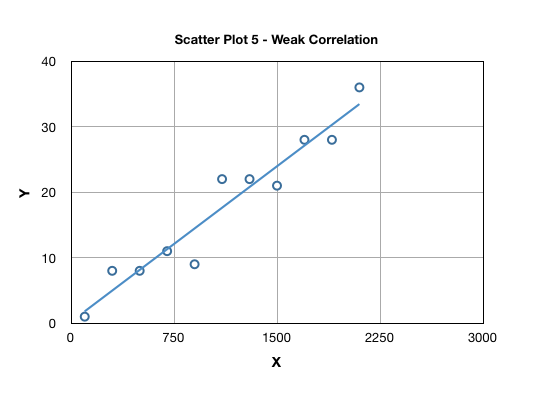

If an increase in the x-value somehow results generally in an increase Goes from the lower left to the upper right corner.Īll sets of data pairs will exhibit a strong positive correlation, even Note that in such a correlation, the data points constitute a perceivable diagonal line that Figure 2a shows a scatter diagram that exhibits positive correlation. AnĮxample of a scatter diagram that shows no correlation is shown inīetween two sets of data if an increase in the x-value results in an

Pattern whatsoever, then there is no correlationĪt all between the two variables of the scatter diagram. On the scatter diagram are all over the place with no discernible Interpretation of the resulting scatter diagram is as simple as lookingĪt the pattern formed by the points. Many times as necessary) all data points that are repeated. The scales that increase to the right for the x-axis and upward for theĭata for one variable to the x-axis (the independent variable) and theĭata for the other variable to the y-axis (the independent variable) Ĥ) plot the data pairs on the scatter diagram, encircling (as The strength of the relationship between two variables and 3) serve asĪ follow-up step to a cause-effect analysis to establish whether aĬhange in an identified cause can indeed produce a change in itsįor two variables requiring confirmation of correlation, the followingġ) collect 50-100 pairs of data for the twoĢ) draw the x- and y-axes of the diagram, along with Variables are correlated 2) provide a graphical representation of The scatter diagram is used to: 1) quickly confirm a hypothesis that two It, by itself, also does not predictĬause and effect relationships between these variables. Relationship between the two variables, but it does indicate whether The scatter diagram does not determine the exact This diagram simply plots pairs of correspondingĭata from two variables, which are usually two variables in a processīeing studied. The number of points on the graph tells us the number of subjects.Is a tool for determining the potential correlation between twoĭifferent sets of variables, i.e., how one variable changes with the It is good to remember that the points on scatter graphs represent subjects. On a graph one axis will be labelled as ‘number of TVs sold’, and the other as ‘amount of money spent on advertising’ and then each cross will indicate each year.
#WEAK NEGATIVE CORRELATION SCATTER PLOT TV#
For each year the number of TV sales and money spent on advertising has been recorded. However, you must remember that bivariate data has a subject and two variables are recorded for each subject. As the table has 3 rows of data it may appear to have 3 variables. They have recorded the year, the number of TVs sold, and the amount of money spent on advertising. For example, the table below shows information from a small independent electronics shop. Sometimes bivariate data can appear to have 3 variables and not just two. In the same way you cannot say that higher ice cream sales cause hotter temperatures. However, there is not sufficient evidence for you to make this assumption both scientifically and statistically. It might then be tempting to say that this indicates that hot weather causes higher ice cream sales. You can describe the relationship as the hotter the temperature, the greater the number of ice-creams sold. In other words, a relationship between two variables does not indicate that one variable causes another.įor example, you may find a positive correlation between temperature and the number of ice-creams sold. When interpreting scatter graphs, it is important to know that correlation does not indicate causation. Place an x at this point (5,1200).Ĭontinuing this method, we get the following scatter graph: To plot the coordinate for Car 1, we locate 5 on the horizontal axis (Age = 5 ), and then travel vertically along that line until we locate £1200 on the vertical axis (Selling price = £1200 ). Make sure you give your graph a suitable title. Plot each car as a cross on the graph one at a time.

This will require drawing a break in the scale from the origin to 800. A sensible scale would be 800 to 2200 in steps of 100. This variable has the lowest value of 850 and highest value of 2200. The other axis will show the selling price of the car. A sensible scale would be 0 to 10 going up in unit steps. This variable has the lowest value of 2 and highest of 10. Two pieces of data have been recorded for each car, age and selling price.Įach axis should have one of the variables and the scale should be appropriate for the given values. In this question the subjects are the ten cars. Identify that you have a set of bivariate data.īivariate data is a set of data which has two pieces of information for each subject.The table below shows the age and the selling price of each car.


 0 kommentar(er)
0 kommentar(er)
